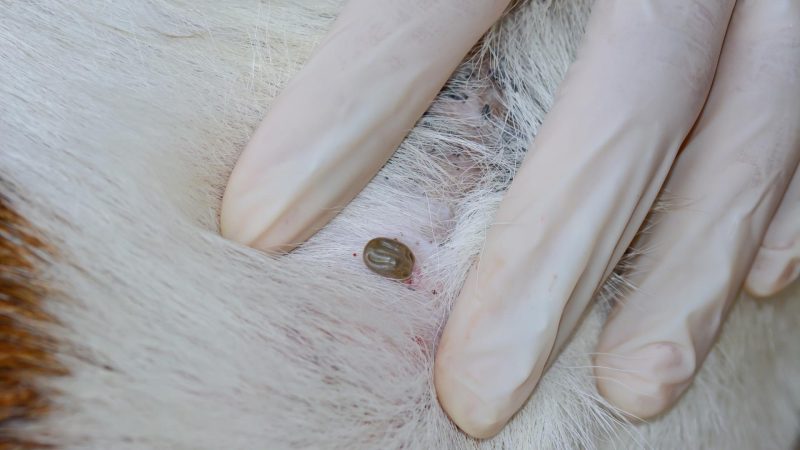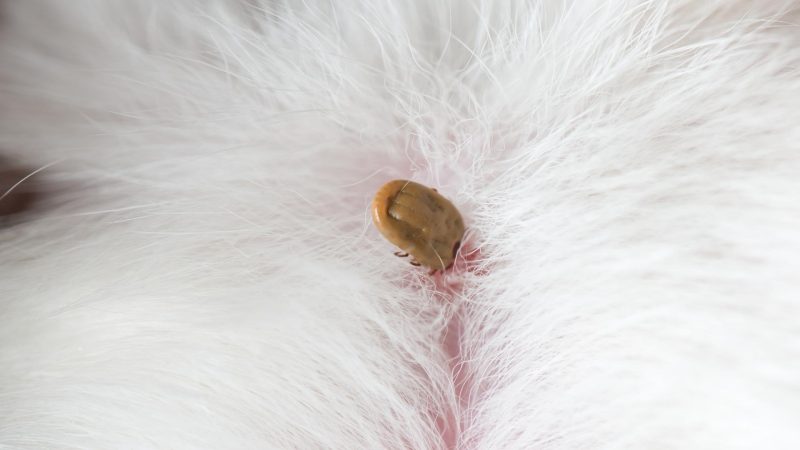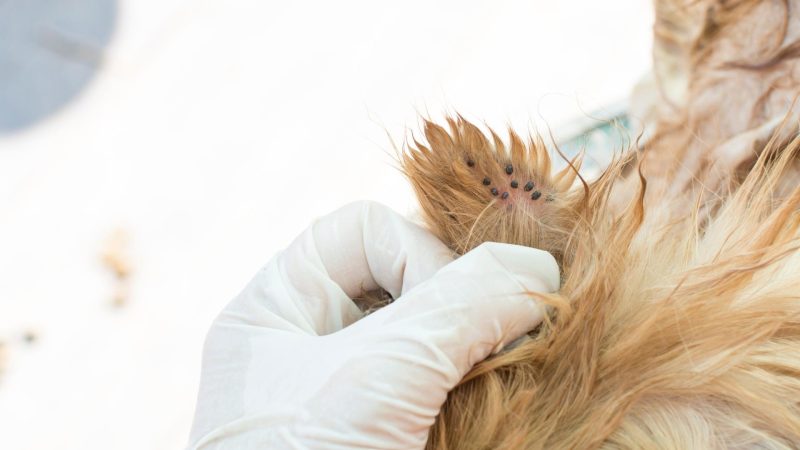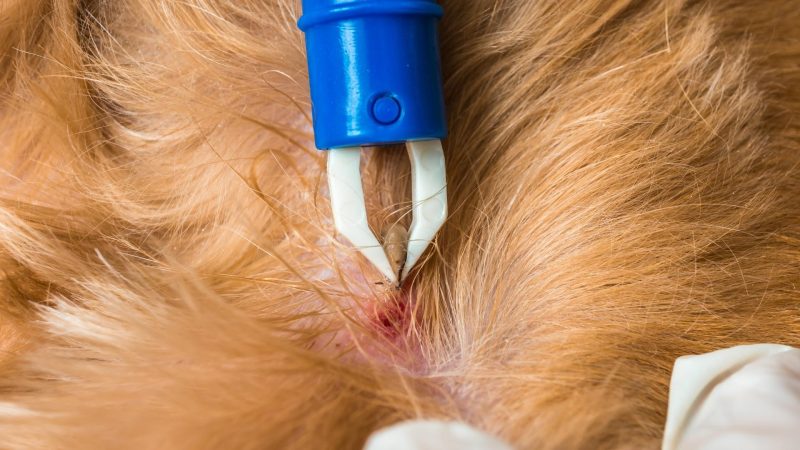Dogs will happily greet you when you reach your home after an exhausting day at work. Additionally, they would get excited when you start to rub their bellies, play with them or give them their favorite food. But what happens if you found engorged ticks on their bodies? Will you still cuddle with them? Probably, not!
How to remove an engorged tick on dogs? Here are the steps:
- Prepare the needed tools and materials.
- With the use of tweezers, grasp the tick as possible to the dog’s skin.
- Once you have a good grasp of the tick’s body, carefully pull it upwards.
- Clean and sanitize the bite location.
- Check the other parts of the dog’s body for the existence of engorged ticks.
- Assess for the presence of tick-borne illnesses.
- Prevent future ticks from biting your dog.
In this article, we’ll identify important facts about tick bites and the efficient ways of preventing and solving devastating tick infestations.
Do Ticks Hurt Dogs?

Ticks may hurt dogs when they bite them, but the pain is tolerable and not cause for concern. However, they transmit diseases and are excellent vectors of bacteria and viruses including the likes of Babesiosis, and Anaplasmosis.
These diseases can manifest on dogs through symptoms, such as fever, loss of appetite, lethargy, joint pains, weight loss and recurrent diarrhea, and vomiting. Frequently observe and monitor for these signs to prevent the worsening of the sickness or the possibility of death.
What Does a Tick Look Like on a Dog?

When a tick attaches to your dog, it may appear like tiny raisins clinging to your pet, but with a lighter shade.
American dog ticks are typically ¼ inch in length but may measure ½ inch or more when fully filled with blood. They are reddish to brown in color and have white to gray markings on their back. Also, they are usually seen attached and sucking blood on the dog’s head, neck, ears, collar area, legs, groin, and toes.
What Does a Tick Bite Look Like on a Dog?
A tick bite may look like a tiny red bump on the dog’s skin. It is usually inflamed and swollen, which forces dogs to repeatedly scratch and scrape their bodies. This typically resolves after a few days.
Should I Remove Ticks From My Dog?

It is advisable to remove ticks from your dog as soon as possible. The sooner you remove these pests, the lesser are the chances of your dog acquiring tick-borne diseases. Also, repeated tick infestation may cause anemia or severe blood loss which may be detrimental to their overall health and well-being.
Can You Tell How Long a Tick Has Been Attached?
If the tick’s body is already engorged, it may mean that it has been attached to your dog for two to ten days already. On the other hand, if its body is not yet fully filled with blood, it may signify that it has recently attached to your pet, probably for a couple of hours.
However, the time of attachment may also depend on the life cycle of a tick. It is said that the larvae of these pests will cling to their hosts for three days while the nymph and adult species of ticks will attach for four and seven to ten days, respectively.
What Happens if You Don’t Remove a Tick From Your Dog?
If ticks are not removed from your dog for a long period of time there is a possibility of acquiring skin infections and abscesses that may transform into a systemic infection if not managed right away.
What Happens to a Tick After It Is Engorged?
When a tick becomes engorged, it detaches from its host to look for a partner. Once these ticks mate, the female will lay numerous eggs, and then both of them will die.
Furthermore, a tick may fall off by itself. This usually occurs when it becomes fully filled with blood and starts to search for a mate.
What Happens if a Tick Dies While Attached?
A tick may die while being attached to its host. It may be due to the pesticides or tick repellents that were sprayed on the host’s skin or when the latter repeatedly scratches its body. This is not a problem as the dead ticks will just fall off naturally.
Steps on Removing Ticks on Dogs
Here is a step-by-step guide on how to remove ticks on dogs:
Step 1: Prepare the needed tools and materials. You will need a pair of gloves for safety and sanitation purposes. Then, prepare a pair of fine-tipped tweezers for the removal of ticks, and a disinfectant solution, soap, and water or antiseptic creams for the pet after-care.
Step 2: With the use of tweezers, grasp the tick as close as possible to the dog’s skin. The tips of the tweezers must be positioned strategically on the tick’s body.
Step 3: Once you have a good grasp of the tick’s body, carefully pull it upwards. The pulling must be done in a steady and straight manner. Gradually increase the pressure while pulling it until the tick is completely removed. Do not overly twist or rotate the tweezers when detaching the engorged ticks. Dispose of the detached ticks properly.
Step 4: Clean and sanitize the bite location. This can be done by applying a disinfectant solution or soap and water on the site of the bite. You can also apply antiseptic cream to the wounded area to sanitize it.
Tips in Removing Ticks on Dogs
- Scan the other parts of the dog’s body for the existence of engorged ticks. These blood-sucking creatures may cling to the other parts of your dog’s body, such as on neck, ears, head, legs, groin, toes, and muzzle. If you discover more ticks on these areas, remove them using the procedure above.
- Assess for the presence of tick-borne illnesses. Look for unusual symptoms like fatigue, changes in behavior, inability to move, vomiting, fever, and loss of appetite.
- Prevent future ticks from biting your pet dogs. Monitor your dog’s body frequently for a possible recurrence of tick infestation. Bathe your pets with tick-killing shampoo and comb their hair regularly. Also, always clean your surroundings and wash your pet beddings at least once a week.
How Are Ticks Treated?

The presence of ticks can be controlled by the administration of anti-tick drugs on dogs. If you don’t want your pets to have a greasy or slimy feeling, it is best to give them oral medications. This can effectively kill ticks when absorbed in the dog’s bloodstream and transferred to it through their bites.
On the other hand, if you prefer instant relief from ticks or your dogs vomit when they take medications, you can apply topical solution or anti-tick sprays and collars to them. This will repel ticks easily as it is believed to be more effective than the oral route.
How Do I Get a Tick off My Dog Without Tweezers?
There are other ways of getting ticks from your dog aside from using tweezers. Tools such as tick twisters and remover sets can be of big help in detaching pests from dogs easily and conveniently. Also, you can apply repellents to the skin of your dogs to hasten the removal of ticks.
If you don’t have these tools available near you, you can just remove them by hand but use protective gloves. This is done to protect yourself from the diseases and illnesses that the ticks may carry.
What Happens if Tick Head Stays in a Dog?
If a tick head stays on your dog, it is not recommended to manually remove it. When you forcefully take it from the dog’s skin, there is an increased chance of acquiring infection. Therefore, the ideal thing to do is to just wait for it to detach as it will just fall off naturally.
Should You Take Your Dog to the Vet After Removing a Tick?

Generally, it is not necessary to take your dog to a veterinarian after removing a tick. However, if your dog experiences symptoms of tick-borne diseases such as fever, severe lethargy, weight loss, constant lack of appetite, and vomiting, then there may be an urgent need to bring your pet to an animal doctor. Your dog might have Ehrlichiosis, Rocky Mountain Spotted Fever, Babesiosis, Lyme Disease, and other tick-borne illnesses.
What Will Make a Tick Back Out?
Some say that applying petroleum jelly or nail polish will make a tick back out. However, the effect is the opposite. It will cause the tick to cling and burrow deeper on the dog’s skin. Thus, it is not generally recommended.
If you want a tick to back out from dogs, you can apply natural or chemical repellents on their bodies in the form of , collars , powders , or shampoos . This is especially true if these products contain permethrin, a substance that is considered a potent tick killer.
No products found.
What Essential Oil Will Make a Tick Back Out?
Several reports have stated that essential oils can repel ticks and make them back out. Good examples of these are the oils coming from the following plants:
- Oregano: The cedrol that is found on this plant can ward off ticks if applied in concentrated and high dosages.
- Red Thyme: Its carvacrol content and antiseptic qualities are effective in getting rid of ticks.
- Neem Seed: There is strong evidence that suggests the effectiveness of this plant against tick larvae. It helps in the easy detachment of ticks from the dog’s body.
Summary
Tick infestation on dogs is often left untreated and unmanaged as it usually occurs clandestinely. It is typically not detected until symptoms of tick-borne illnesses begin to manifest. Thus, it is important to regularly monitor and check your dog’s bodies for the existence of ticks and other parasites, including any unusual sign or behavior that may require immediate medical intervention.
List of Sources
Diseases Transmitted by Ticks. (2020). Centers for Disease Control and Prevention.
American Dog Tick. The University of Maine.
Skerrett, P. J. (2013). Matchless strategy for tick removal; 6 steps to avoid tick bites. Harvard Medical School.
- How to Get Rid of Copperheads | Practical Guide - August 27, 2023
- How to Get Rid of Corn Snakes | What Makes Them Aggressive? - August 27, 2023
- How to Get Rid of Alligators | Safety Measures and Removal Methods - July 16, 2023
